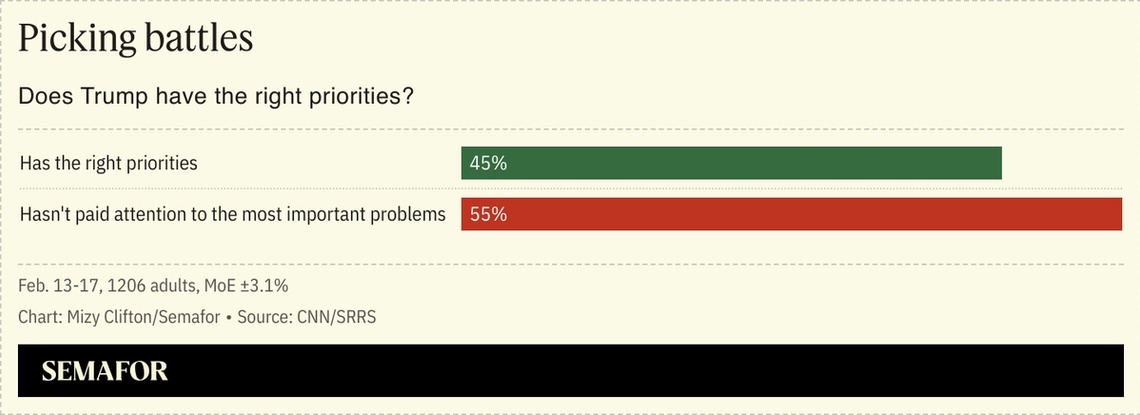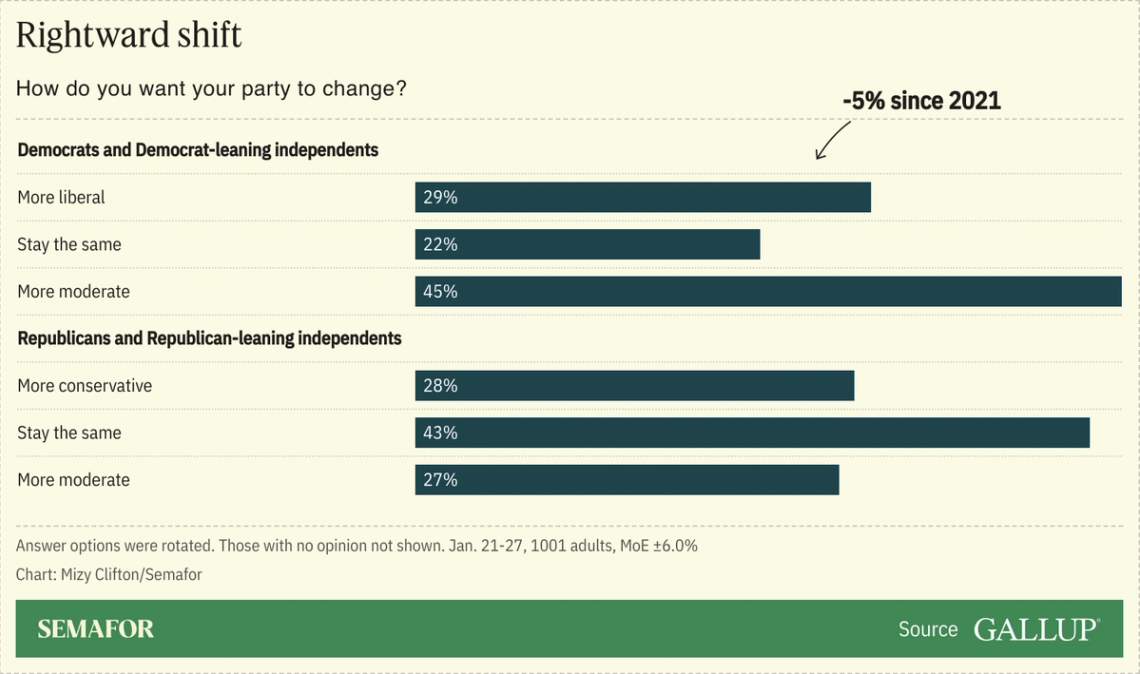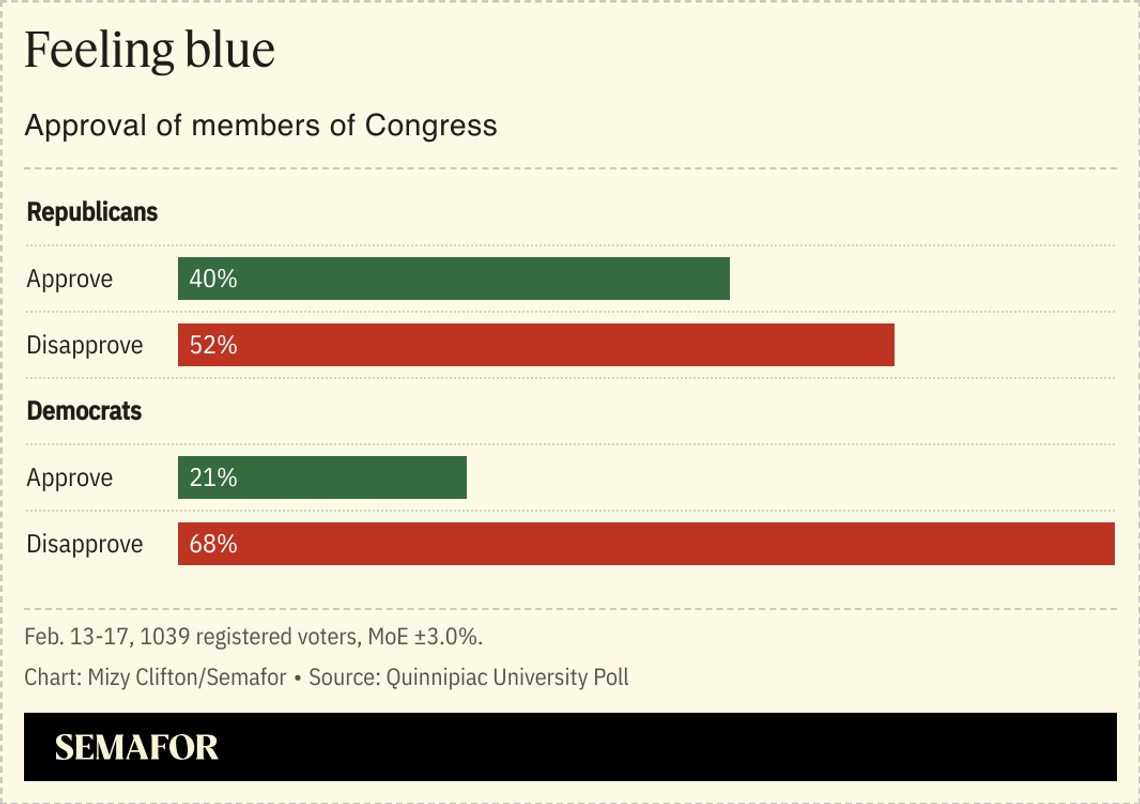 Polls Why did voters elect Donald Trump last year? The Democratic answer is “to lower prices.” That’s politically convenient for them to say: Prices aren’t down, and fighting over that issue is possible without any reform of their own party. The Republican answer is broad, accepting the MAGA premise that voters wanted the entire government turned upside down and an end to foreign military entanglements. So far, Republicans support everything Trump is doing; Democrats oppose it (4% support shutting down USAID and the CFPB), and independents largely oppose it. Only 30% of independents support ending DEI in the federal government, one of the early wins that Republicans were most confident about.  Since Nov. 5, Democrats have been in an open-air trauma session about their failure to message effectively to voters. With a few small exceptions — two House Democrats fretting about “boys in girls’ sports” , a large minority of House and Senate Democrats voting to pass the Laken Riley Act — they have delayed any larger debate about their policies. Their voters sound ready for that discussion, with more of them saying the party should move right, even though Harris ’24 ran to the right of Biden ’20 on significant issues, like the role of government in creating equitable racial outcomes. Republicans are more satisfied with their victorious party; four years ago, the surge in GOP voters believing that the party wasn’t conservative enough was a reaction to Trump losing the presidency. Sure enough, he ran a more conservative campaign last year than he did in 2024.  Every newly elected president gets a honeymoon; every newly dis-empowered opposition party gets the opposite. But there’s not much precedent for the weakness of congressional Democrats right now — not in Quinnipiac’s polling. A majority of self-identified Democrats disapprove of the job their party is doing in Congress. That’s weaker partisan support than Republicans had after their landslide loss to Barack Obama in 2008, and significantly weaker support than Democrats had eight years ago, the first time they lost the White House to Donald Trump and the Congress to Republicans. Ads Club for Growth Action/YouTube Club for Growth Action/YouTube- Building America’s Future, “Susan Crawford’s Dangerous Decisions.” It’s an iron rule of politics: Every race for a law enforcement or judicial job becomes an argument about sentencing guidelines. This is the first ad from Elon Musk’s PAC in Wisconsin’s Apr. 1 Supreme Court race, and it’s entirely focused on the sentencing of a pedophile who sexually assaulted a child but was “let off” by Judge Susan Crawford with four years in prison; the maximum allowed sentence would have been 100 years.
- Susan Crawford for Wisconsin, “Buy Off.” Crawford’s using the playbook that’s worked for Democratic-endorsed state court candidates recently — pounding the Republican nominee as anti-abortion and soft on crime. When the BAF ad buy was announced last week, Crawford’s campaign accused Musk of “trying to buy off (GOP-backed nominee) Brad Schimel and take over control of the Wisconsin Supreme Court.” There’s no Musk mention in her first ad after that news, but the theme is that Schimel will make decisions based on who gives him money.
- Club for Growth Action, “Feed.” The Club for Growth has earned a reputation for early, hard-hitting ads, often getting the airwaves to itself before anyone’s actually started a campaign. In Kentucky, it is already trying to soften support for Rep. Andy Barr, the seven-term congressman from Lexington, who is positioning to replace Sen. Mitch McConnell if he retires next year, telling interviewers that Donald Trump deserves a Republican senator who’ll work with him. (McConnell, who turned 84 yesterday, announced his retirement the same day.) This is a kitchen-sink spot that hits Barr for his birth name (Garland Hale Barr IV), his votes to increase the debt limit, and his support from banks, relabeled “woke Wall Street banks” here, a hint of what strategies think will play in GOP primaries now.
Scooped!What’s up with big liberal donors? This is a big question, smothered in secrecy; years ago, I knew one reporter who booked a room at a liberal donor conference to increase his chance of grabbing documents before custodians cleared their meeting rooms. (He was successful.) This triple-byline New York Times study of liberal donor panic is the best I’ve seen about the world these elites have been living in since November, fretting about audits and vengeance and wondering what the point even is of donating to Democrats right now. Next - 39 days until Wisconsin’s state supreme court election
- 256 days until off-year elections
- 619 days until the 2026 midterm elections
David RecommendsNot to get ahead of Semafor’s weekend media newsletter, but NPR’s David Folkenflik and Tom Dreisbach have a story I’d wanted to read: The changing of the media guard at Donald Trump’s White House. Eight years ago, the first Trump administration took some steps toward elevating “alternative” media, while working with the more established press corps (nonpartisan, liberal, and conservative) that usually filled the Brady Room. This administration has moved more deliberately to elevate pro-Trump journalists and outlets, while continuing to work with the “traditional” press corps. That explains one mystery hanging over the beat: Why no outlet has walked out of the gaggles or briefings, to protest the exclusion of the Associated Press for refusing to use White House language in its stylebook. “If mainstream media were to leave, they said, the outlets that are outright supportive of Trump are poised to fill the gap.” |